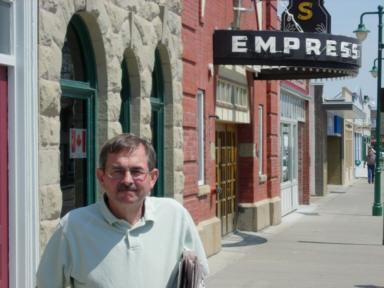1
Fort Macleod is also the ancestral home
of the Royal Canadian Mounted Police. The RCMP is our
national police force, much like the FBI. It was
established in 1873 to bring law and order to western
Canada. They were originally the North-West Mounted
Police, then in 1920, when they became a national police
force, they became the Royal Canadian Mounted Police.

Royal Canadian Mounted Police Poster
The Mounties started a mounted patrol
musical ride in the 1870s, commingling the band and the
horses. We carry on their traditions here during the
summertime. Of course, today we have our own detachment
of real Mounties here. They drive around in cars
[laughter].
Fort Macleod is well-known in the
film industry?
Fort Macleod has longstanding ties to the
motion picture business. Brokeback was one of
many movies that have been filmed here.
The very first motion picture made in
Fort Macleod was Cameron of the Royal Mounted,
filmed in 1920. It was a silent “cowboys and
Indians” feature, made long before the days of John
Wayne.
More recently, during the late 1970s,
parts of Amber Waves, with Dennis Weaver and
Kurt Russell, were shot here. Then, in 1988 we did a
movie called Betrayed, with Debra Winger and Tom
Berenger. Also, parts of the 1996 television remake of In
Cold Blood were shot in Fort Macleod. A couple of
years ago the film Badland was shot here. Its
writer, producer, and director is Francesco Lucente. It
is the story of an American soldier who returns from Iraq
and struggles with his family relationships.
2
At about the same time, the Robin
Williams comedy RV was made, in part, just west
of here. Although portions of it were filmed in
Vancouver, the prairie scenes of RV were shot
east of Fort Macleod.
We actually have a new movie coming to
Fort Macleod, called Passchendaele. The star,
director, and writer is Paul Gross, a strong Canadian
actor. He was in Due South, a television series
in which a Canadian Mountie was seconded [sent] to
Chicago to work with the police there. Passchendaele
is a World War I movie about the Battle of Passchendaele,
that was fought in 1917 in Flanders, Belgium. There were
over 100,000 young men from the Canadian Expeditionary
Forces directly involved, and more than 16,000
casualties.
Paul’s grandfather fought there as a
young man and when Paul was growing up he heard stories
of that battle. He decided that in remembrance of his
grandfather he would do the movie. The west end of Fort
Macleod’s Main Street, and parts of Second Avenue,
will soon be transformed into a 1917 Calgary streetscape,
and military recruiting office, for that film.
Do pay a visit to our Empress Theatre
which was built in 1912, making it Alberta’s oldest
continuously operating theatre. There you will see some
extraordinary murals of local figures: Colonel Macleod,
Dan Boyle, Chief Red Crow, and Chief Crowfoot. Among them
is Broncho Billy Anderson, who was the first motion
picture cowboy. He starred in The Great Train Robbery,
made by Thomas Edison in 1903, and later released in long
form in 1910. You’ll also see Faye Ray, of King
Kong fame. She was born 20 minutes away at Cardston,
Alberta. Then there is W.C. Fields. His portrait pays
homage to the evolution of the theatre and the art, from
vaudeville, to silent films, to the talkies.

Broncho Billy Anderson and W.C. Fields’
Portraits
at the Historic Empress Theatre
3
We are very pleased to have all of this
filmmaking activity here for many reasons. The citizens
of Fort Macleod get involved in the movies as extras. The
making of a film here is always a great news story. The
production crews use the subtrades [carpentry,
electrical, landscaping, etc.] and in doing so, inject
money into the economy. So in many ways our involvement
in making movies is an important economic development
tool. Above all, by hosting filmmakers, we are able to
showcase Fort Macleod to the world.
You market the town to filmmakers
in search of locations?
We are part of the Alberta Film
Commission. The Film Commission asks filmmakers to define
their requirements. Based upon the information they
provide, we put together a collage of pictures and ask
“Do you like this?” Then they respond and often
request additional information. In the third step of the
process, they actually visit and take a look at the
location. There is a vast motion picture industry and we
are just a small piece of it.
For instance, a production company may
need a church. There are artistic people in the movie
business that have in mind a certain “look”
that they are seeking. Through the exchange of photos,
conversations, and visits, we might bring them here to
film one of our churches.
In addition to Fort Macleod’s
vintage buildings, remember that we offer some of the
most impressive western range scenery imaginable. We have
real open range, not some rent-a-horse-for-an-hour thing.
In nearby Longview, the classic western Unforgiven
was made. Kevin Costner’s Open Range was
shot just south of there. This is real cowboy country!
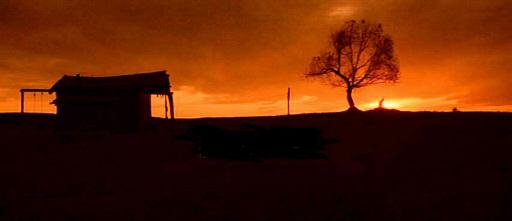
Alberta landscape from Unforgiven (1992)
Of course, you don’t win them all. A
year ago, Brad Pitt did The Assassination of Jesse
James. The film’s locations manager came and he
liked our Main Street. He photographed the town. These
people have a different perspective than you and me. They
are looking at the background, and the foreground, and
things like that. I spent a day with him here, but I knew
I was in trouble because he mentioned that the next day
he was headed for Winnipeg. Sure enough, they filmed
their street scenes in Winnipeg.
4
When did you first hear of Brokeback
Mountain?
Darryl Solly, a great guy, was the
locations manager for Brokeback Mountain. He
knows Alberta like the back of his hand. Darryl called me
early in 2004 and said, “I need to talk with
you.” He came down and brought his camera and we
walked the land. At that stage it was all very
confidential. I did not know precisely what he wanted, or
the film he was working on.
We are a film-friendly community; we
greet them with open arms. Anything we can do to help and
support filmmakers, it’s “Yep, done!” and
on from there. So we try to accommodate them whether they
need traffic control for a street closing, or, for
instance, for Brokeback Mountain’s Fourth
of July Fireworks scene, our fire department was on
standby just in case they were needed. We do what we can
to provide service to the industry. In this case it meant
taking them into the Queen’s Hotel [Cassie’s
Bar] and seeing how filming there might work; introducing
them to the people who own buildings, such as Harley
Brown [owner of the Laundry Apartment], and helping them
come to an accommodation; securing the ballpark for the
Fourth of July scene, things like that.
The pictures Darryl made during his
initial visit were packaged up and sent to Ang Lee,
Michael Hausman, and a friend of mine, Murray Ord. They
obviously liked what we sent them!
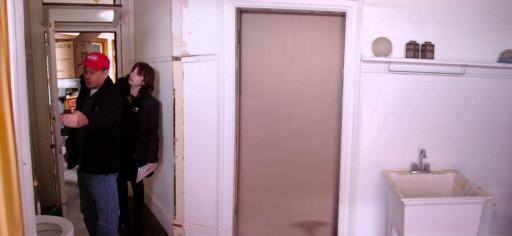
Ang Lee and Judy Becker survey a prospective Fort
Macleod filming location
Spring 2004
One story: There was a lady living in the
[laundry] apartment. Unfortunately, she has since passed
away. Darryl walked up there and knocked on the door out
of the blue. She was doing her thing and there is this
big guy saying, “Hi, my name is Darryl Solly. I am a
film locations manager and we are making a movie. Is it
OK if we look at your apartment?” “Well,
okay,” she said.
5
Of course, they wanted a scene with
outside stairs. That was the marching order—to find
a place with outside stairs and a window overlooking
them. Because there was a scene ... right?
So Darryl talked to the lady and
explained everything and said they would like to use her
place for the movie, that they would compensate her and
move her to a motel while they filmed, pay her expenses,
a moving van would come to the apartment and move and
return her possessions, and they would give her an
honorarium. Then Darryl left, and I remember my phone
rang and it was this lovely lady, and she said, “I
just had this guy here and he wants to use my apartment
for a movie. Is this for real?” And I politely
reassured her that it was true, and with that she was all
excited.
Towns sometimes get burned by
filmmakers who do not pay their bills.
It is symptomatic of the film industry in
general. And it is no different from, say, doctors. Just
as there are, say, two percent bad doctors out there,
most of the guys in the film business are very
professional, but once in a great while you will run
across a bad one.
Over the years we’ve had some really
low-budget films and documentaries. A few years ago, a
German documentary company did something in the mines
near the Crowsnest Pass. They ran up some bills. A
colleague of mine there received a phone call saying the
production crew had disappeared, and they owed money for
food and rooms and such. So they tracked them and picked
them up in Montreal.
That is just one of the things that is
out there that you have to be aware of, but when you are
dealing with professional people there is a high
standard, and there is no issue at all. I think the only
thing you have to be careful of is that production
companies do a great deal of subcontracting [carpenters,
electricians, etc.], so where you have subcontractors
there is a potential problem if a subcontractor fails to
pay his employees. But that is something about the
industry at large, and it has nothing to do with Fort
Macleod in particular.
You market to two
constituencies—the filmmakers and the people of Fort
Macleod?
Yes, there is some local anxiety, a bit
of the unknown. Some retail merchants are concerned,
quite legitimately, that if, say, their street is closed,
it could diminish sales. That is where we come to a
business accommodation. We might say, “Tell us what
your sales were on this day last year and we will
compensate you for the difference between what you made
this year and what you did make then.” Where a
merchant told us, “Last year I made $1,000 and this
year I made $800,” Darryl wrote him a check for
$200.
The filmmakers also pay for the use of
the locations. That is one of the direct economic
development benefits of something like this.
Approximately $200,000 was invested, donated, or spent by
the Brokeback Mountain production crew in Fort
Macleod during May and June 2004. They booked all of the
motels in town for three weeks to a month. The motel
owners benefited from that. They would order $750 worth
of donuts every morning [laughter]. They tied off Main
Street, so they donated $3,000 to the Chamber of
Commerce. For the Fire Department’s assistance with
the Fourth of July scene, they made a donation of $6,000.
I received summaries of the checks issued here in Fort
Macleod: the Java Shop, the Queen’s Hotel, Harley
Brown, the lady in the [laundry] apartment, and so on.
6
Johnny’s Restaurant is a nice little
restaurant with good Chinese food, run by a husband and
wife. Of course, Johnny relies upon tourists who are
staying in the motels to visit his restaurant and eat
lunch or dinner. In May and June 2004, our motels were
all full with the Brokeback production. Of
course, the filmmakers have their “circus” and
their own canteen. This is necessary because they are
frequently working at unusual hours. So Johnny was not
seeing the same volume that he would normally get. He
talked to me and I approached Darryl and suggested that
he see Johnny. And Darryl went in and said to Johnny in a
positive way, “How can I help you?” and they
were able to reach an accommodation.
Then there is the whole spin off of movie
tourism. Last year we had all these tourists who came
into the Queen’s Hotel and had a beer, and went into
the Java Shop and ordered apple pie and coffee, staying
here, eating here, taking pictures, rediscovering these
places. That is very special. Budget Travel
magazine ran a great feature, “The Top 10 Movie
Spots,” [January 2006 issue] and we were mentioned
prominently.
Is this tourism phenomenon true
of other films that were made here?
This is unusual. There is a whole Brokeback
Mountain subculture, like Lord of the Rings—everybody’s
going to New Zealand to see where it was made. To Brokeback
Mountain fans we say, “Please come and
enjoy!”
And the production itself?
For Brokeback Mountain, the
production people were all top professionals. They wanted
a certain look; they wanted the 1960s and 1970s. Their
artistic people were incredibly thorough. I remember when
they went into the Java Shop, they were looking at every
light inside. And the walls! They were holding paint
swatches on the walls and everything.
In situations where the art department
came in and said, “We need to change this white
paint to cream,” they’d paint it cream. Then
when they were finished filming, they’d say to the
owner, “Do you like this? If not, we will paint it
back to white.” The owners got some free painting
done that way!
7
It was an exciting time. I remember
standing over at Harley’s [Laundry Apartment]
surrounded by a hundred-person production crew working
everywhere. And I said to myself, “This is
fun!” There were many gratifying moments like that.
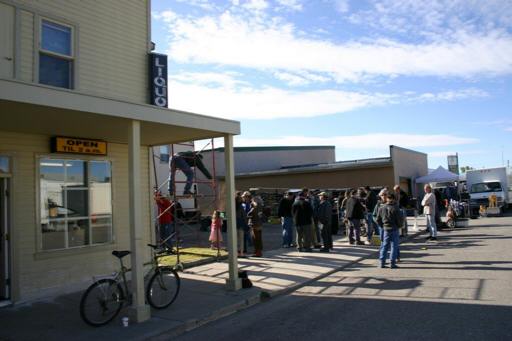
Production Activity at the Laundry Apartment
May 2004
We all patiently waited for the film to
be edited and go into distribution. I spent more than a
year waiting, and then one day I read about Brokeback
Mountain’s triumph at Cannes! It was deeply
gratifying.
Did the Mayor or Town Council
need to grant approval for a film of this scale to be
made here?
Yes, but they are on side and fully
cooperative. If a street needs to be closed or whatever,
they are willing. If the filmmakers need Public Works to
barricade an area, we’ll do it. If, as in the case
of Passchendaele, they want to use special
street lights, our electrical department will put them up
for them.
Did people say to you, “What
is this movie about?”
Oh, very much so. We knew it was a
western movie set in the 1960s to 1980s, in which Fort
Macleod would become Riverton, Wyoming. A lot of towns in
Montana and Wyoming and Alberta are quite similar, so
that was cool.
8
Some citizens felt they had been
deceived. Did you?
No, I don’t think anybody paid any
attention to it. After the movie was made and it caught
the world’s attention, some people in Fort Macleod
complained. When we had a showing at the Empress Theatre,
a small number of folks reacted negatively. There were a
number of letters to the editor of The Macleod
Gazette, and then it died down.
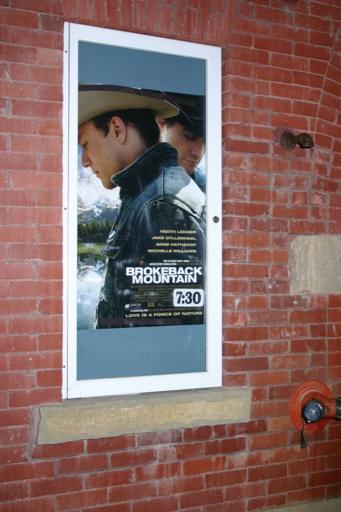
Poster for Empress Theatre Screening of
Brokeback Mountain, January 2006
There were some people, some “real
cowboys,” who weren’t going to go see it. I do
not think that they have to this day.
Brokeback Mountain
is quite possibly the most enduring film to be made in
Fort Macleod.
It is wonderful to have a classic movie
that will be around for the next 100 years or whatever.
That is just great.
Thank you! You have been very
generous with your time and have made us feel very much
welcome in this lovely town.
9
|
